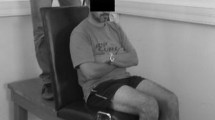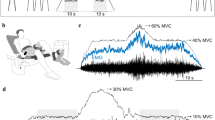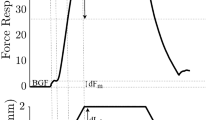Summary
In an effort to more fully investigate spinal reflex pathways in humans, we measured the isometric force-time curve of the patellar (PTR) and Achilles (ATR) tendon-tap reflex in 12 college age subjects. We also conditioned the tendon jerk with a contralateral or ipsilateral tendon-tap stimulus, to ascertain the effects of segmental inputs on crossed-spinal reflex activity. The conditioning stimulus preceded the test reflex by 25,40, 55, 70, 85, 100, 115, 130 or 145 ms. The results demonstrate that a tap to the contralateral patellar tendon produced long-latency excitation of quadriceps motoneurons, but a tap to the contralateral Achilles tendon produced short-latency facilitation and long-latency inhibition of the triceps surae motoneurons. Also, a conditioning tap to the contra- or ipsilateral patellar tendon produced a brief short-latency facilitation that was followed by a distinct, long-latency inhibition of triceps surae motoneurons. These results demonstrate that motoneuron excitability changes can be produced as a result of ispi- and contralateral segmental inputs. Moreover, these excitability changes may be long-lasting and only appear after a relatively long-latency. Several neurophysiological mechanisms are proposed to contribute to these changes.
Similar content being viewed by others
References
Baxendale RH, Rosenberg JR (1976) Crossed reflexes evoked by selective activation of muscle spindle primary afferent endings in the decerebrate cat. Brain Res 115: 324–327
Baxendale RH, Rosenberg JR (1977) Crossed reflexes evoked by selective activation of tendon organ afferent axons in decerebrate cat. Brain Res 127: 323–326
Bishop B, Machover S, Johnston S (1968) Role of the gamma motor system in the achilles tendon reflex of hemiplegic patients. ArchPhys Med Rehabil 49: 698–707
Brooke JD, McComas AJ, Yoon P, Wilson MK, McIlroy WE (1988)Homosynaptic depression is substantial in soleus but infrequent in vastus medialis. Neurosci Abstr 9: 1061
Burke D, Gandevia SC, McKeon B (1984) Monosynaptic and oligosynaptic contributions to human ankle jerk and H-reflex. J Neurophysiol 52: 435–448
Burke JR, Kamen G, Koceja DM (1989) Long-latency enhancement of quadriceps excitability from stimulation of skin afferents in young and old adults. J Gerontol 44: M158-M163
Faganel J, Dimitrijevic MR (1982) Study of propriospinal interneuron system in man. J Neurol Sci 56: 155–172
Gassel MM, Ott KH (1970) Local sign and late effects on motoneuron excitability of cutaneous stimulation in man. Brain 93: 95–106
Gassel MM, Ott KH (1973) Patterns of reflex excitability change after widespread cutaneous stimulation in man. J Neurol Neurosurg Psychiat 36: 282–287
Goode DJ, Van Hoeven JV (1982) Loss of patellar and Achilles tendon reflexes in classical ballet dancers. Arch Neurol 39: 323
Granit R, Homma S, Matthews PBC (1959) Prolonged changes in the discharge of mammalian muscle spindles following tendon taps or muscle twitches. Acta Physiol Scand 46: 185–193
Hagbarth KE, Hagglund JV, Walling EU, Young R (1981) Grouped spindle and electromyographic responses to abrupt wrist extension movements in man. J Physiol 312: 81–96
Harrison PJ, Jankowska E, Zytnicki D (1986) Lamina VIII interneurones interposed in crossed reflex pathways in the cat. J Physiol 371: 147–166
Hart BA (1986) Fractionated myotatic reflex times in women by activity level and age. J Gerontol 41: 361–367
Hultborn H, Wigstrom H, Wangberg B (1975) Prolonged activation of soleus motoneurones following a conditioning train in soleus Ia afferents: a case for a reverberating loop? Neurosci Lett 1: 147–152
Kamen G (1979) Serial isometric contractions under imposed myotatic stretch conditions in high-strength and low-strength men. Eur J Appl Physiol 41: 73–82
Kamen G, Koceja DM (1989) Contralateral influences on patellar tendon reflexes in young and old adults. Neurobiol Aging 10: 311–315
Kamen G, Kroll W, Zigon ST (1981) Exercise effects upon reflex time components in weight lifters and distance runners. Med Sci Sports Exerc 13: 198–204
Kirk RE (1982) Experimental design: procedures for the behavioral sciences. Brooks/Cole Publishing, Belmont CA
Koceja DM (1989) Organization of segmental reflexes in untrained and endurance-trained subjects. Unpublished Doctoral Thesis Indiana University
Koceja DM, Kamen G (1988) Conditioned patellar tendon reflexes in sprint- and endurance-trained athletes. Med Sci Sports Exerc 20: 172–177
Koceja DM, Burke JR, Kamen G (1990) Quadriceps excitability is enhanced by a conditioning tap to the Achilles tendon. Electromyogr Clin Neurophysiol 30: 415–421
Koceja DM, Burke JR, Kamen G (1991) Organization of segmental reflexes in trained dancers. Int J Sports Med (in press)
Matthews PCB (1984) Evidence from the use of vibration that the human long-latency stretch reflex depends upon spindle secondary afferents. J Physiol 348: 383–415
Meier-Ewert K, Humme U, Dahm J (1972) New evidence favouring long loop reflexes in man. Arch Psychiat Nervenkr 215: 121–128
Robinson KL, McIlwain JS, Hayes KC (1979) Effects of H-reflex conditioning upon the contralateral alpha motoneuron pool. Electroenceph Clin Neurophysiol 46: 65–71
Schieppati M (1987) The Hoffmann reflex: a means of assessing spinal reflex excitability and its descending control in man. Prog Neurobiol 28: 345–376
Secher NH, Rorsgaard S, Secher O (1978) Contralateral influences on recruitment of curarized muscle fibers during maximal voluntary extension of the legs. Acta Physiol Scand 103: 456–462
Sherrington CS (1906) The integrative action of the nervous system Scribners, New York
Shieh JY, Leong SK, Wong WC (1985) Effect of spinal cord hemisection on rubrospinal neurons in the albino cat. J Anat 143: 129–141
Vandervoort AA, Sale DG, Moroz J (1984) Comparison of motor unit activation during unilateral and bilateral leg extension. J Appl Physiol 56: 46–51
Wiesendanger M (1969) The pyramidal tract: recent investigations on its morphology and function. Ergeb Physiol 61: 71–136
Author information
Authors and Affiliations
Additional information
Offprint requests to: D.M. Koceja, HPER 170
Rights and permissions
About this article
Cite this article
Koceja, D.M., Kamen, G. Interactions in human quadriceps-triceps surae motoneuron pathways. Exp Brain Res 86, 433–439 (1991). https://doi.org/10.1007/BF00228969
Received:
Accepted:
Issue Date:
DOI: https://doi.org/10.1007/BF00228969




